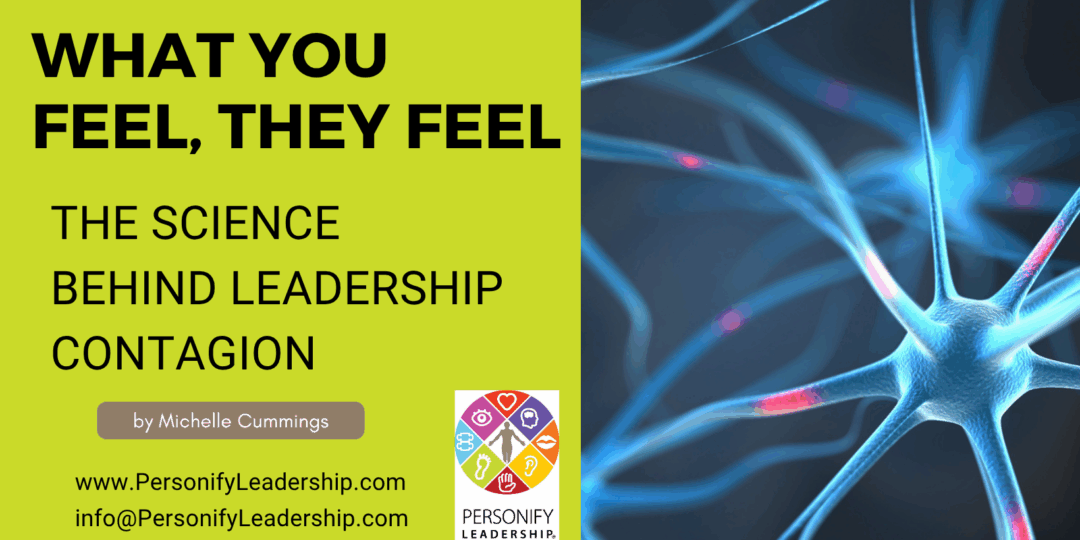Standing Tall When It’s Not Easy
- Aug 08, 2025
- By personifyadmin
- In Newsletters
- 0 Comments
Leadership is not just about making the right calls, it is about owning them, even when the results are difficult or the reaction is not what you hoped for. Taking responsibility for your words and actions builds credibility, trust, and respect, even in challenging situations.
It is easy to claim ownership when the outcome is positive. The true test comes when the decision you made is met with resistance or the results are less than ideal. In those moments, some leaders may distance themselves from the choice or shift blame to others. Strong leaders do the opposite. They step forward and own their role.
(more…)Calm Is Contagious: How Your Presence Shapes the Room
- Jul 24, 2025
- By personifyadmin
- In Newsletters
- 0 Comments
by Michelle Cummings
We often think of leadership as something we say or do. But some of our strongest signals come not from our words – but from our presence. The way we carry ourselves in moments of stress, transition, or pressure has ripple effects on everyone around us. That’s where mirror neurons come in.
Mirror neurons are a part of the brain that help us sense and mirror the emotions, behaviors, and intentions of others. They are why yawns are contagious and why a team can feel tense when a leader walks into the room with tight shoulders and a clenched jaw. Our brains are wired to sync. This has huge implications for leadership.
(more…)Every leader takes steps each day that signal to their team who they are and what they stand for. Some steps move them forward, toward clarity and ownership. Others keep them stuck, trapped in cycles of blame or avoidance. The difference lies in mindset, whether a leader operates from a victim mentality or an accountable one.
The victim leader mindset is easy to spot. These leaders tend to deflect responsibility, point fingers when things go wrong, or feel powerless in the face of challenges. While this stance may offer temporary relief from pressure, it erodes trust over time. Teams under victim leaders often mirror that behavior, leading to cultures of excuse-making, disengagement, and stagnation.
(more…)Owning Your Part in the Outcome
- Jun 03, 2025
- By personifyadmin
- In Newsletters
- 0 Comments
When a plan fails or results fall short, it is human nature to look outward first. We might point to shifting priorities, lack of resources, or the actions of others. While these factors may be real, strong leaders start by looking inward. They ask themselves, “What could I have done differently?”
This mindset is not about self-blame. It is about ownership. By focusing first on your own actions and decisions, you give yourself the power to influence future outcomes. Blaming others may feel easier in the moment, but it leaves you with little control to make changes that lead to improvement.
(more…)What You Feel, They Feel: The Science Behind Leadership Contagion
- May 29, 2025
- By personifyadmin
- In Newsletters
- 0 Comments
by Michelle Cummings
Leadership is not just about what you say. It’s also about what you transmit. Neuroscience now shows that your emotions and behaviors don’t stay contained – they ripple. At the heart of this ripple effect are mirror neurons, a set of brain cells that help people reflect the emotional tone of those around them. Whether you walk into the room stressed or composed, frustrated or calm, others are likely to mirror what they observe in you.
This is not just about mood. It’s about influence. If your team sees you leading with optimism, presence, and grounded energy, they are more likely to respond with motivation and clarity. If they pick up tension, anger, or fear from you – even if unspoken – that emotional tone becomes the room’s new baseline. Mirror neurons are always on. They don’t wait for permission. They reflect what’s modeled.
(more…)It is easy to match the behavior we receive, especially when that behavior is unkind or passive-aggressive. A sarcastic comment may get a sarcastic reply. A cold shoulder might be met with one of your own. In the moment, it can feel like self-protection or even fairness, but it rarely leads to the outcome you want.
Mirroring negative behavior can escalate tension, damage trust, and distract from the real issue. While it may give a temporary sense of satisfaction, it often leaves you questioning whether you acted in line with your values. Leadership requires the ability to pause, reflect, and choose a better path forward.
(more…)Lead the Energy You Want to See
- Apr 01, 2025
- By personifyadmin
- In Newsletters
- 0 Comments
People often take their cues from the leader in the room. Whether you realize it or not, your mood, body language, and energy set the tone for how others respond. If you want your team to show focus, optimism, or determination, the most effective way to inspire it is to model it yourself.
Energy is contagious. When leaders bring a calm, steady presence to a stressful moment, it helps others stay grounded. When they bring enthusiasm and engagement to a new project, it makes the work feel exciting and worth the effort. The opposite is also true; negativity or anxiety from a leader can quickly ripple through the team.
(more…)Be the One to Break the Cycle
- Feb 18, 2025
- By personifyadmin
- In Newsletters
- 0 Comments
Negative cycles in the workplace can take many forms, recurring conflicts, unproductive communication patterns, or the silent tension that comes from unresolved issues. These cycles drain energy, erode trust, and impact performance. It is easy to believe that the only way they will end is if everyone changes at once. But real leadership means recognizing that change can start with you.
When you choose to act differently, you disrupt the pattern. If a conversation always turns tense, you can shift your tone, ask a new kind of question, or approach the discussion at a different time. If a teammate responds with sarcasm, you can remain calm and focused instead of matching the tone. These small, deliberate choices can create a ripple effect that gradually changes the dynamic.
(more…)Even the most composed leaders face moments when someone speaks or acts in a way that feels disrespectful. In those moments, it is natural to want to respond in kind. Matching their tone or attitude may feel like standing your ground, but it often fuels conflict rather than resolving it.
Reacting in the heat of the moment can quickly derail a conversation or relationship. What might have been a small misunderstanding can turn into a bigger problem simply because emotions overtake thoughtful decision-making. The real leadership skill lies in choosing a response that protects your integrity and keeps the situation from escalating.
(more…)
Tag: Feet of a Leader
© 2012-2025 Personify Leadership. All Rights Reserved.










Recent Comments